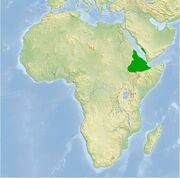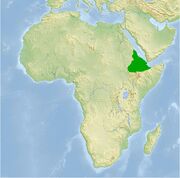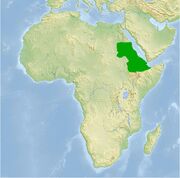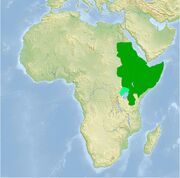In this timeline, Aksum faces much more favourable circumstances than in OTL. In OTL, Roman economy in Egypt - Aksum`s primary trading partner - decayed from the 4th century onwards, while the rise of Islam in the 7th century cut the Christian kingdom off from any contact both with the Christian nations of Europe and from possible trading partners in Eastern Africa, Arabia, the Mediterranean, Persia and India. Forced to withdraw into the isolation of the Ethiopian highlands, the Abessinian kingdom remained a marginal geopolitical factor throughout the rest of OTL history; its culture and political institutions remaining relatively conservative.
In this timeline, Rome`s economy booms, and Arabia is controlled by another Christian polity, the Kingdom of Sheba. Aksum has a lot of opportunities to develop into a great empire, and it seizes them, gradually expanding along the Nile and in the lands between Nile and Indian Ocean, until they are faced for the first time with a strong indigenous African opponent, allied with Aksum's naval rivals, Sheba: the Kirinyaga Alliance.
This is a short outline of the cultural, social, economic, political and territorial developments of the Aksumite Empire from the PoD in 251 CE to the end of the first millennium CE.
Territorial Expansions[]
Conflict with Sheba and the Development of a Purely African Core[]

Kingdom of Aksum at PoD, 251 CE
Decius` persecutions of Christians caused the migration of many Roman Christians from Africa, Cyrenaica, Egypt, Palestine and Syria - the Christian strongholds in the Roman Empire - across the imperial borders, Southwards to the Berbers and into Aksum, or South-Eastwards into Arabia. More polities in this religion are Christianised, and they are Christianised earlier than in OTL. The Southern Arabian Kingdom of Sheba converts earlier than Aksum, and it attracts many Christian refugees, who - often relatively competent craftsmen - strengthen both Sheba`s military and economic power. Thus, in the early 260s, while the Roman Empire undergoes its revolution, Sheba conquers all his quarrelsome neighbour

Kingdom of Aksum, 300 CE
s: Himjar and Hadramaut, and it also eliminates Aksumite presence on the Arabian peninsula.
A few decades later, Aksum has turned into a Christian kingdom, too, and the two kingdoms coexist relatively peacefully, with Aksum controlling the African Red Sea coast and Sheba controlling the Arabian Red Sea cost. But the important transformation has happened: Aksum no longer orients itself towards (linguistically and culturally similar) Southern Arabia, and pursues an independent foreign policy, aimed at gaining Rome's support for becoming a dominant factor in North-Eastern Africa.
The Conquest of Kush[]
After Rome's direct Southern neighbour on the Nile, the Meroitic Kingdom, had fallen apart in 303, Aksum began its "service" for Rome, taking over Meroe`s position as Rome`s "buddy" in the region, by subduing the nomadic tribe of the Blemmyes - the only Sahara-dwellers who had not come under Garama's control - in 315/6. Then, Aksum actively exploits the inner conflicts and divisions among Meroe's successor states to annex and conquer them one by one:
- In 338, the Alodian Queen Amanipilade calls to Aksum for help against a Nobatian invasion. After discussions with Aksum's King Ezana, Amanipilade converts to Christianity, and so do many of her subjects in a great baptism before the joint military operation of Aksumites and Alodians against the Nobatians. The ensuing defeat of the Nobatian invaders is ascribed to divine intervention in Alodian and Aksumite legends formed during the Christianisation of all of Alodia and its integration as a relatively autonomous sub-kingdom into Aksum.
- In 383, Aksum's Emperor Mehadeyis intervenes in an ongoing war between Makuria and Nobatia, which threatens Aksum's Alodian province. Allying itself with the Nobatian King Charamadoye, Mehadeyis' troops conquer Makuria. In Makuria's capital, Tungul, King Shekanda ceremoniously accepts the overlordship of Aksum's Emperor Mehadeyis. Makuria becomes another subordinate kingdom with relative autonomy. Nobatia's King Charamadoye is prevented by the Aksumites from plundering Tungul too much. Small ensuing skirmishes between Nobatians and the Imperial Aksumite Army go badly for the retreating Nobatians.

Empire of Aksum after the Conquest of Alodia, Nobatia and Makuria, 415 CE
- In 385, Nobatia's King Charamadoye converts himself to miaphysitic Christianity. He is baptised by the Patriarch of Aksum, who, together with Charamadoye, appoints bishops for Nobatia. In 415, King Silko officially accepts Aksumite suzerainty, under pressure from Nobatian bishops who fear a Simonist revolution.
Swallowing the three Kushitic successor states of Meroe, each of which had been almost as large as Aksum itself, Aksum has transformed from a middle-sized kingdom into an empire with multiple levels of administration. With more than half of the emperor's subjects speaking non-Habesha, Cushitic languages, the miaphysitic Christian Church of Aksum becomes the cultural bond unifying the empire.
Controlling the Coast[]
The Aksumite Empire took a lot of time to absorb its new territories - a time, in which Christianisation was completed and the church restructured society to a great extent. The empire`s economy blossomed during the 5th and 6th centuries CE, and it depended more and more on the ability to control as much of the coast at the Horn of Africa, which was of great importance for both Roman-Indian and Sassanid-Swahili trade. Increasingly, Aksumite merchants engaged in trade with the Bantu along the Indian Ocean coast, too. It was time, it was felt in Aksum, for the empire to subdue the Oromo, Biyomaal and Rahaweyn tribes who inhabited the lands to the South and East of the Ethiopian Highlands and who, besides rivaling for control over the coast and its profitable options for piracy, also repeatedly raided the increasingly wealthy Aksumite towns.

Empire of Aksum after the Conquest of Somalia, 630 CE
Upriver on the White Nile[]

Empire of Aksum after the Conquest of Nilotia, 700 CE
The First East African War[]

Empire of Aksum after the First East African War
Vassalising the Developing Societies of the Great Lakes[]

Aksumite Empire and its vassal Kingdom of Kitara, c. 1000 CE
Political and Administrative Developments[]
Compared to the Roman Empire, the Kingdom of Aksum had very little administration and state structures at the PoD. Throughout its conquest and integration of the Kushitic lands in the 4th and 5th centuries, very little was changed about this. The imperial state remained in the background, the subdued kingdoms retained their relatively meagre structures, too.
Only the growing towns and cities made a more rational and comprehensive administration necessary. Adulis, on the Red Sea coast, was the first to adopt Roman-style structures of urban self-organisation (the model being the democratic civitas of the Second Republic).
This changed in the 6th and 7th centuries.
Socioeconomic Developments[]
Cultural Developments[]
///continue editing here - rests below///
The internal political structure of the early Empire of Aksum was not laid down in a written document or constitution. It evolved in the course of Aksum's annexation of the formerly Kushitic / Meroitic kingdoms of Alodia, Makuria, and Nobatia in the 4th and early 5th centuries and remained, with adaptations, valid until the establishment of a constitutional monarchy in 760-2. The Empire was governed by Tigray emperors from the dynasty of their former kings of Aksum until the beginning of the 7th century. There were no formal limits to the emperor`s power. Factually, though, Aksumite emperors intervened very moderately in the affairs of their subjects until the late 7th century and they did not sponsor extreme idolisations or ritual honorings. (Aksumite coins bore a Christian cross and various Ge'ez mottos instead of the king´s or emperors faces.)
Below the emperor, parts of the empire which had previously been sovereign states, like Nobatia, Alodia and Makuria, kept their kings and queens. Beside these local kingdoms, other entities exerted informal, but relatively high degrees of autonomous self-rule, from the town council of Adulis to the tribal structures of acephalous segmented societies like the Nuer.
Even within Aksum, the emperors factually shared their power with the Patriarch of the Aksumite Christian Church, who in turn was appointed by a synod of bishops, who in turn were appointed only by a consensus of the Patriarch and local powerhouses like royal courts or tribal assemblies.
The political system of Aksum was built, thus, to a great degree on an implicit principle of near-consensus. This social consensus was built neither on ethnic homogeneity (the empire`s peoples were Tigray and other Habesha, Cushitic peoples, as well as Nilotic ethnicities like the Nuer and the Luo), nor on the common Christian religion (other Christian sects as well as non-Christian faiths of the animists and even small groups of Jews and Muslims - the only ones worldwide after the fall of Yathrib - were free to practise and did so). Its historical sources are still unclear (some trace it back to the traditions of segmented societies), but it is almost certain that the stability of this political system, in which different authorities were not seriously challenged and yet did not extend their spheres of influence unduly, depended on economic advantages brought about by an efficiently organised trade, a quick development of crafts, excellent irrigation systems and the adaptation of agricultural innovations from the Roman Empire - in short: the absence of conflicts over resources. High living standards and the promise of advancement for everyone who sought it, while those who wanted to preserve traditional lifestyles were left to do so, too, were the backbone of Aksum's imperial peace. After a phase of imperial expansion in the 4th and early 5th century, Aksumite emperors seem to have understood that autonomous groups, left to pursue happiness in their own ways, were more likely to contribute to such a development than forcefully controlled underlings. Aksumite elites, be they of Cushitic or Habesha origin, in turn saw the advantages of imperial peace and infrastructure and upheld them instead of endangering them (a social peace and cohesion similar to that of the Northern provinces of the Roman Empire, only without actual democracy).
On this basis, an empire-wide management of security, justice, educational, religious and infrastructural issues was possible, even though centralised administration was rather limited.
When the foundations of this consensus were endangered by renewed conflicts over resources, increasing social inequality among those who had left traditional lifestyles behind, scarcity of land due to a growing population, and a Roman neighbour who pursued their interests in a more self-confident way, the social balance and stability of the Aksumite Empire underwent a crisis, which led to the transformation of the Aksumite Empire into a constitutional monarchy.
The first clear sign of change were the militant controversies concerning the succession of Emperor Gersem in the 610s. Instead of accepting the modus operandi of nominating an heir from Gersem's Tigray clan as emperor, the Nobatian King Tokiltoeton called for an electoral convent, similar to the ones held with the purpose of choosing a Patriarch. Although this demand was never officially rejected by anyone in particular, Aksum nevertheless underwent an interregnum of eighteen months before such an unheard-of convent actually convened. In the meantime, different social groups had positioned themselves, and their differences were fueled by the intervention of foreign powers, who pursued their own interests. Saba supported a dynasty from Adulis, the "Solomonites", whose members were related to the Saban royal family; Rome supported a female Makurian pretender who had grown up and attended school and university in Roman Alexandria, etc. In the end, Tokiltoeton was crowned as the first Cushitic emperor. He not only pursued foreign policies which brought him in confrontation with Rome and Saba, but also began to formalise and centralise his administration. This aggravated underlying tensions, for which the old consensus system provided no institutionalised outlets or methods of mediation. After Aksum`s defeat in the war with Rome and the installation of a Rome-friendly Makurian dynasty, the centralisation of power and the aggravation of tensions increased. Emigration to Rome and to colonies on the Swahili coast as well as agricultural expansion into the lands of indigenous peoples in the South relieved some of these tensions and aggravated others instead - now the indigenous populations of the South began to revolt against Aksumite rule, with which they had not had any trouble in the preceding centuries.
This, in turn, led to Aksum's annexation of land further to the South and to the First East African War, which the Aksumite Empire only survived due to mass mobilisations, for which King Ezana IV. promised political participation of the masses in turn.
Thus, after the First East African War, Aksum received its first written constitution, which limited the powers of the Emperor, established a central and a regional administration as well as a bicameral parliament and chartered the civil rights which, in the early phase of Aksum's empire, had been taken for granted by everyone in this mostly liberal-minded country.
Salvador79 (talk) 14:41, February 15, 2015 (UTC)
